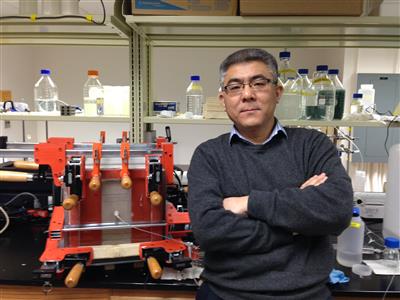
Credit: Provided photo
April 3, 2014
by Aaron R. Conklin
Like a dogged detective chasing a quick-moving fugitive across wide and varied terrain, Shangping Xu has spent the last decade doggedly pursuing his quarry. While Xu, an associate professor of geosciences at UW-Milwaukee, isn’t tracking a criminal, he is tracking something that’s potentially harmful to all of us: the progress of antibiotic-resistant bacteria through the subsurface system.
In Wisconsin, many private wells are contaminated by bacteria, and manure has long been suspected as the primary source. Previously, it was believed that manure-derived bacteria simply decayed where they were shed—or, in the case of farms and fertilization, where the manure was spread. However, closer study of manure revealed that not only can the number of bacteria increase more than 10 times over 24 hours, but many of them are resistant to commonly used antibiotics like tetracycline. Researchers also found that when the resistant bacteria seeped into the groundwater, they could travel farther and faster than anyone expected.
“The antibiotic resistance may be surprising to the public, but not to scientists,” said Xu. “But why does antibiotic-resistant bacteria travel faster? We’re fascinated by this question.”
Backed by grants from the University of Wisconsin Water Resources Institute (WRI), Xu has spent the last four years looking for the answer. In a previous WRI-funded research project, Xu’s lab identified the molecular mechanism that affects the transport of antibiotic-resistant E.coli through groundwater in saturated quartz sands and the vadose zone, the subterranean zone in which groundwater remains at atmospheric pressure.
Xu’s team zeroed in on a specific protein on the outer membrane of bacteria called ToIC. Bacteria that heavily express the protein are not only highly resistant to commonly used antibiotics, but can also speed quickly through the sandy aquifer materials because the protein alters key surface properties such as hydrophobicity—the ability to combine with or dissolve in water—of the bacterial cells. As a result, instead of attaching and being immobilized by the surface of the sand, the bacteria remain in the water and travel with the flow.
Xu’s latest WRI project focuses on one of the few areas he has yet to study—the fractured dolomite zone, specifically, the area ranging from Green Bay to Milwaukee along the Lake Michigan shoreline. Here, Xu explained, sandy topsoil lies atop dolomite, and bacteria traveling through the soil can spread within the dolomite system. Xu and his colleagues went out to quarries to cut out and collect dolomite samples, then injected the antibiotic-resistant bacteria into the rocky material to see how much of it was immobilized and how much passed through unencumbered.
“This is not commonly done,” says Xu of the lab work. “And it’s actually quite challenging.”
While results aren’t yet final, preliminary findings suggest that the transport behavior of bacteria within the dolomite shares the same pattern as within quartz sands and the vadose zone.
“It seems dolomite has no positive charge to immobilize the bacteria,” said Xu. “They’ll travel right through with little retardation.”
Xu’s findings could have health implications for the safety of water in farmland wells.
“When farmers spread manure, it can spread beyond where they’ve placed it, and a farmer’s well is typically not far from the field,” explained Xu. “Because we now know that antibiotic-resistant bacteria travel fast and even longer distances than we originally thought, if you’re seeing bacteria in the well, it’s even more likely to be antibiotic-resistant.”
The ultimate goal, of course, is the creation of a system to track the bacteria, the way law enforcement officials track criminals on house arrest.
“Once we fully understand the process, we’ll be able to do source tracking, to point to where we know exactly where the contaminated bacteria are coming from,” Xu said. “If contamination is a one-time episode, it’s no big deal. But in this case, there’s a continuous supply of contamination.”
The findings from Xu’s lab are also applicable to beach sands. At this point, Xu’s research can dovetail with the beach health monitoring research work of Dr. Sandra McLellan, work that’s funded by the University of Wisconsin Sea Grant Institute, WRI’s sister institute in the UW Aquatic Sciences Center.



